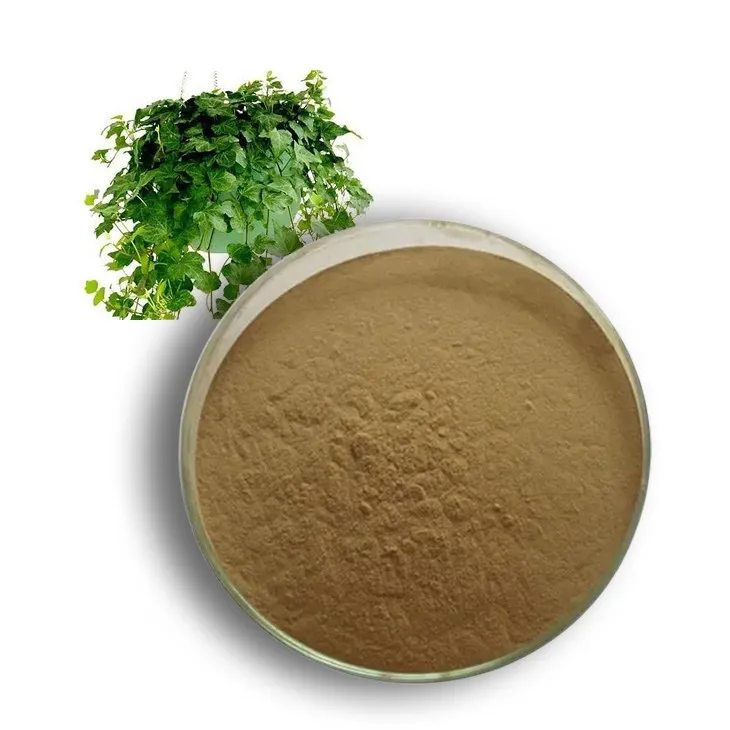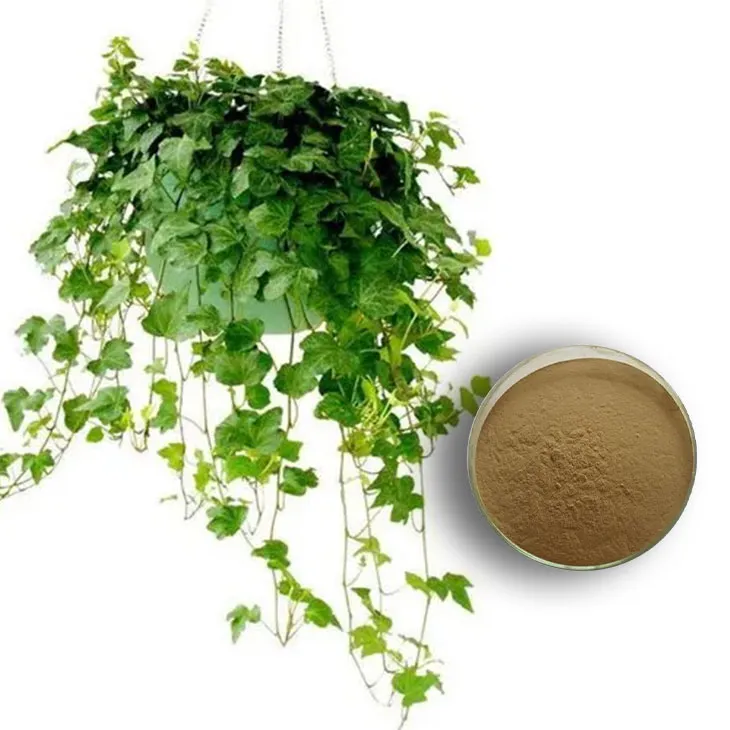- 0086-571-85302990
- sales@greenskybio.com
The process of extracting hederasaponin from ivy extract.
2024-11-28

1. Introduction to Ivy Saponins
Ivy saponins are a group of significant bioactive substances. Chemically, they possess complex structures. Their chemical structure is characterized by a triterpenoid aglycone moiety, which is often glycosylated with various sugars. These unique structures endow ivy saponins with a wide range of potential applications. For example, in the field of medicine, they have shown potential anti - inflammatory, antioxidant, and antimicrobial properties. In addition, they may also be used in the cosmetic industry due to their beneficial effects on skin health.

2. Comparison of Extraction Methods
2.1 Traditional Extraction Methods
The traditional extraction of hederasaponin from Ivy Extract mainly focuses on the use of organic solvents. Organic solvents such as ethanol, methanol, and chloroform are commonly employed. - Ethanol extraction: Ethanol is a popular choice because it is relatively safe and can dissolve a wide range of substances. In the ethanol extraction process, ivy plant materials are usually soaked in ethanol for a certain period. The ratio of ivy material to ethanol is crucial. For example, a ratio of 1:5 (ivy material: ethanol) may be used. After soaking, the mixture is often stirred continuously at a certain temperature, usually around room temperature to slightly elevated temperatures (e.g., 30 - 40°C). Then, the solvent is evaporated to obtain the crude extract containing hederasaponin. - Methanol extraction: Methanol has a high solubility for many organic compounds. However, it is more toxic than ethanol. When using methanol for extraction, similar procedures are followed as in ethanol extraction. But more strict safety precautions need to be taken due to the toxicity of methanol. - Limitations of traditional methods: Although these traditional organic solvent extraction methods have been widely used, they also have some limitations. One of the main problems is that they may extract a large number of impurities along with the hederasaponin. Moreover, organic solvents are often flammable and harmful to the environment, which poses challenges to waste disposal.
2.2 Advanced Extraction Methods
In recent years, advanced extraction methods have emerged as more environmentally friendly and efficient options. - Enzymatic extraction: Enzymatic extraction is a promising method. Enzymes can selectively break down the cell walls of ivy plants, which helps to release hederasaponin more effectively. For example, cellulase and pectinase can be used. In this process, the ivy plant material is first treated with the appropriate enzymes under specific conditions. The enzyme concentration, reaction time, and temperature need to be carefully controlled. For instance, a cellulase concentration of 0.5 - 1% (w/v), a reaction time of 2 - 4 hours, and a temperature of 40 - 50°C may be suitable conditions. After the enzymatic reaction, the hederasaponin can be extracted using a suitable solvent, usually water or a mild organic solvent. This method can significantly improve the extraction yield and purity of hederasaponin compared to traditional methods. - Supercritical fluid extraction: Supercritical fluid extraction, especially using carbon dioxide (CO₂) as the supercritical fluid, has also attracted much attention. Supercritical CO₂ has properties similar to both liquids and gases. It can penetrate into the plant material easily and selectively extract hederasaponin. The extraction process is carried out under high pressure and a specific temperature. For example, the pressure may be around 10 - 30 MPa and the temperature around 35 - 60°C. This method has the advantages of being non - toxic, non - flammable, and environmentally friendly. It can also produce a high - quality extract with relatively high purity.

3. Influence of Extraction Conditions on Yield and Quality
The extraction conditions play a crucial role in determining the yield and quality of hederasaponin. - Ratio of raw materials to solvents: As mentioned before, the ratio of ivy raw materials to solvents is an important factor. If the amount of solvent is too small, the extraction may be incomplete, resulting in a low yield. On the other hand, if the amount of solvent is too large, it may increase the cost and also lead to a higher amount of impurities in the extract. For example, in ethanol extraction, a ratio of 1:5 to 1:10 (ivy material: ethanol) is often considered appropriate, depending on the nature of the ivy material and the extraction requirements. - Extraction temperature: Temperature also affects the extraction process. Higher temperatures can generally increase the solubility of hederasaponin in solvents, which may lead to a higher extraction yield. However, if the temperature is too high, it may cause the degradation of hederasaponin or the extraction of more impurities. In enzymatic extraction, for example, the optimal temperature for the enzyme reaction needs to be maintained. If the temperature deviates from this optimal value, the activity of the enzyme may be reduced, which in turn affects the extraction efficiency. - Extraction time: The extraction time is another key factor. Longer extraction times may seem to increase the yield, but it may also lead to the extraction of more unwanted substances. In traditional solvent extraction, for example, if the extraction time is too long, some secondary metabolites or impurities may be continuously extracted. In enzymatic extraction, if the reaction time is too long, the enzyme may start to degrade or lose its activity, which is not conducive to the extraction of hederasaponin.

4. Purification Process
After extraction, the purification process is vital for obtaining high - quality hederasaponin. - Chromatography techniques: Chromatography is one of the most commonly used purification methods. - Column chromatography: In column chromatography, a stationary phase (such as silica gel or alumina) is packed into a column. The crude extract containing hederasaponin is loaded onto the top of the column, and then a mobile phase (usually a solvent or a mixture of solvents) is passed through the column. Different components in the extract will move at different rates through the column based on their interactions with the stationary and mobile phases. Hederasaponin can be separated from other impurities and collected at a specific elution volume. - High - performance liquid chromatography (HPLC): HPLC is a more advanced chromatography technique. It can achieve high - resolution separation of hederasaponin. In HPLC, a high - pressure pump is used to drive the mobile phase through a column with a very fine stationary phase. The sample is injected into the mobile phase, and the separation is monitored by a detector. This method can accurately determine the purity of hederasaponin and separate it from even very similar impurities. - Recrystallization: Recrystallization is another purification method. The crude hederaSaponin Extract is dissolved in a suitable solvent at a high temperature. Then, the solution is slowly cooled, and the hederasaponin will crystallize out. The impurities will remain in the solution. By repeating this process, the purity of hederasaponin can be further improved.
5. Conclusion
In conclusion, the extraction of hederasaponin from Ivy Extract is a complex process that involves various factors. The choice of extraction method, extraction conditions, and purification process all have a significant impact on the yield and quality of hederasaponin. Advanced extraction methods such as enzymatic extraction and supercritical fluid extraction show great potential in improving the extraction efficiency and environmental friendliness. Meanwhile, the purification process, especially chromatography techniques, is crucial for obtaining high - quality hederasaponin. Future research may focus on further optimizing these processes to meet the increasing demand for hederasaponin in various fields such as medicine and cosmetics.
FAQ:
What is the chemical structure of hederasaponin?
Hederasaponin has a complex chemical structure. It typically consists of a triterpenoid aglycone part and a sugar moiety. The triterpenoid part provides the basic skeletal structure, and the attached sugars contribute to its solubility and some of its biological properties.
What are the potential applications of hederasaponin?
Hederasaponin has several potential applications. It has shown antioxidant properties, which can be useful in preventing oxidative damage in cells. It may also have anti - inflammatory effects, making it a candidate for treating inflammatory diseases. Additionally, it has been studied for its potential in the pharmaceutical industry, perhaps for use in drug development.
How does the enzymatic extraction method compare to traditional organic solvent extraction for hederasaponin?
The enzymatic extraction method has several advantages over traditional organic solvent extraction for hederasaponin. Enzymatic extraction is more environmentally friendly as it reduces the use of potentially harmful organic solvents. It can also be more specific in breaking down the plant material to release hederasaponin, potentially leading to a higher yield and better quality of the extracted product. Traditional organic solvent extraction, on the other hand, may require more complex purification steps to remove solvent residues.
What is the influence of the ratio of raw materials to solvents on the extraction of hederasaponin?
The ratio of raw materials to solvents is an important factor in the extraction of hederasaponin. If the ratio is not optimal, it can affect the yield and quality of the extraction. A too - low ratio of raw materials to solvents may result in incomplete extraction, leaving some hederasaponin in the raw material. Conversely, a too - high ratio may lead to dilution of the hederasaponin in the solvent, making the subsequent purification process more difficult.
Why is the purification process important for obtaining high - quality hederasaponin?
The purification process is crucial for obtaining high - quality hederasaponin. After extraction, the extract may contain various impurities such as other plant components, residual solvents, and by - products of the extraction process. Chromatography techniques in the purification process can separate hederasaponin from these impurities, ensuring that the final product has a high purity level, which is essential for its applications in pharmaceuticals, cosmetics, and other industries.
Related literature
- Extraction and Characterization of Hederasaponin from Ivy: A Review"
- "Advanced Techniques for HederaSaponin Extraction and Purification"
- "The Role of Hederasaponin in Modern Medicine: Extraction Considerations"
- ▶ Hesperidin
- ▶ Citrus Bioflavonoids
- ▶ Plant Extract
- ▶ lycopene
- ▶ Diosmin
- ▶ Grape seed extract
- ▶ Sea buckthorn Juice Powder
- ▶ Fruit Juice Powder
- ▶ Hops Extract
- ▶ Artichoke Extract
- ▶ Mushroom extract
- ▶ Astaxanthin
- ▶ Green Tea Extract
- ▶ Curcumin
- ▶ Horse Chestnut Extract
- ▶ Other Product
- ▶ Boswellia Serrata Extract
- ▶ Resveratrol
- ▶ Marigold Extract
- ▶ Grape Leaf Extract
- ▶ New Product
- ▶ Aminolevulinic acid
- ▶ Cranberry Extract
- ▶ Red Yeast Rice
- ▶ Red Wine Extract
-
Hawthorn Extract
2024-11-28
-
Artichoke Extract
2024-11-28
-
melatonin extract
2024-11-28
-
Horse Chestnut Extract
2024-11-28
-
Resveratrol extract
2024-11-28
-
Cassia Seed Extract
2024-11-28
-
Grape Seed Extract
2024-11-28
-
Centella Asiatica Extract
2024-11-28
-
Senna Leaf Extract
2024-11-28
-
Tongkat Ali Extract
2024-11-28





















